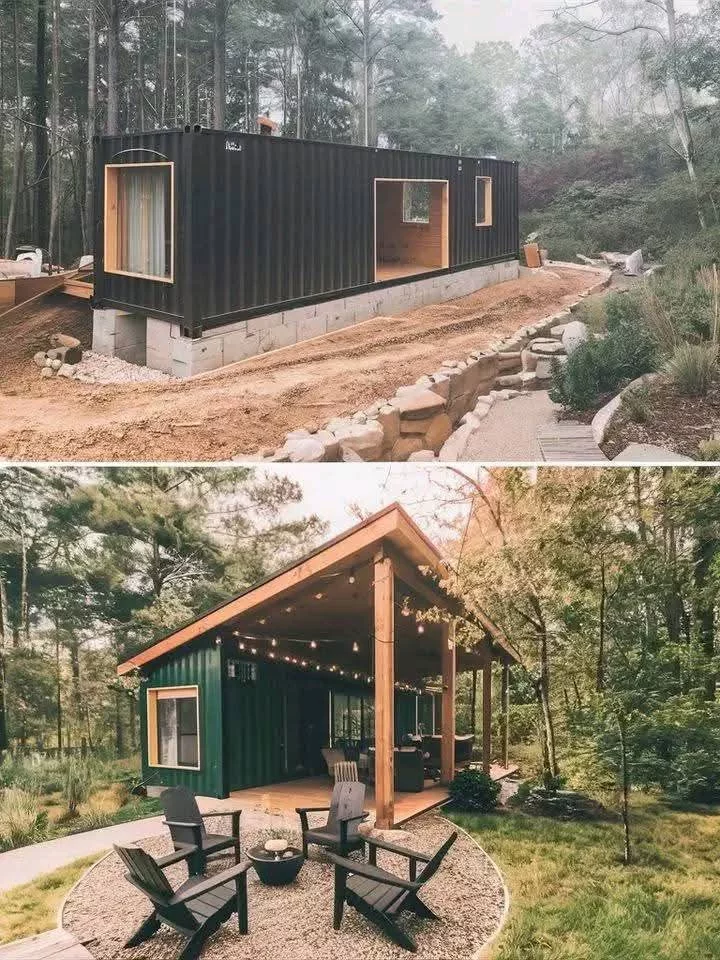South Africa’s climate doesn’t demand heavy insulation, but thoughtful design is key to making a container home comfortable and cost-effective. Rather than over-investing in cold-weather insulation, the priority should be managing heat and sunlight.
Prioritise Shade and Ventilation
Container homes heat up fast. Use roof overhangs, pergolas, or simple shade cloth to block direct sun, especially on west-facing walls. Cross-ventilation through well-placed windows and vents is essential to keep the interior cool without relying heavily on air conditioning.
Extend Without Adding More Containers
Expanding your living space doesn’t always mean buying another container. Tin roof extensions, steel frames, or timber structures can be used to create shaded patios, kitchens, lounges, or storage areas at a fraction of the cost. Covered outdoor areas are especially useful in warm climates and can double your usable living space.
Use Open Space Wisely
Decks, verandas, and outdoor showers add functionality without driving up costs. A container on its own is compact, but placing it alongside an open-air living area or enclosed courtyard can transform it into a complete, comfortable home.
Leverage Low-Cost, Practical Materials
There’s no need to stick to high-end finishes. Fibre cement board, corrugated sheeting, reclaimed timber, and even polished OSB can be styled to look sharp while keeping costs low. Thousands of efficient, attractive examples exist using materials that are durable, low-maintenance, and easy to source locally.
Plan Ahead for Speed
Container homes can go up quickly—but only if you’ve planned thoroughly. Secure permits, prep foundations, organise utilities, and line up materials before delivery. With smart prep, a liveable unit can be installed and made functional in a matter of weeks.
The key is design intelligence: combining the durability of containers with smart, affordable additions that suit the local climate and lifestyle.
40ft Shipping Container Transformation: Why It Makes Sense to Live in One
Container homes aren’t just a design trend—they’re a smart, sustainable lifestyle decision. Here’s why converting a shipping container into your next home could be a practical move:
1. Environmentally Responsible
Repurposing shipping containers reduces construction waste and breathes new life into materials that would otherwise be discarded. It’s an effective way to minimize your environmental impact and support sustainable building practices.
2. Built to Last
Originally engineered to withstand harsh marine environments, shipping containers are made of high-grade steel and are naturally resistant to extreme weather conditions, fire, and seismic activity. This durability makes them a safe, long-term housing option.
3. Affordable & Scalable
Compared to traditional housing, container homes offer a more affordable alternative. They allow for modular expansion—start small and add units as needed—making them ideal for budget-conscious homeowners or those who prefer to invest in experiences over debt.
4. Fully Customisable
Whether you’re after a minimalist studio, a multi-container family home, or a workspace with a view, container homes offer flexible layouts and endless design possibilities. You can stack, join, or modify them to fit your specific needs.
5. Faster Build Times
Since the core structure already exists, construction is significantly quicker than standard builds. Many container homes can be completed in a matter of weeks or months, reducing labour time and letting you move in sooner.
6. Energy Efficient
With proper insulation and eco-conscious upgrades like solar panels or rainwater harvesting, container homes can achieve high levels of energy efficiency—lowering your utility bills while reducing your carbon footprint.
This modern housing solution merges cost-efficiency, sustainability, and adaptability—making it a compelling choice for forward-thinking homeowners.
Requirements for Living in a Shipping Container Home in South African Cities
Shipping container homes are a practical and sustainable alternative to traditional housing, but they must comply with specific regulations in South Africa. Whether you’re planning to build in Johannesburg, Durban, Cape Town, or Pretoria, you’ll need to follow national building laws and local municipal bylaws to ensure your container home is legal and habitable.
National Requirements
All container homes must comply with the South African National Building Regulations (SANS 10400), which cover structural safety, fire protection, ventilation, and energy efficiency. Plans must be submitted to your local municipality for approval and include architectural drawings, elevations, and site layout. Because shipping containers are non-traditional structures, they require Agrément South Africa certification to confirm their suitability as housing units. Builders also need to be registered with the National Home Builders Registration Council (NHBRC). The land must be zoned for residential use, and your home must connect to essential services such as water, sewage, and electricity.
Johannesburg
In Johannesburg, building regulations are strictly enforced. All building plans must be fully compliant with SANS 10400, especially regarding energy efficiency. It’s recommended to work with professionals experienced in container housing to avoid delays or rejections during plan submission.
Durban
Durban’s coastal conditions require that container homes use corrosion-resistant materials and effective insulation. Flood-prone areas may require homes to be elevated or fitted with proper drainage and stormwater management systems. All plans must go through eThekwini Municipality’s approval processes.
Cape Town
Cape Town enforces heritage and environmental guidelines in many suburbs. Depending on the location, you may need to consider aesthetic rules and conduct an environmental impact assessment. Be sure to confirm your site’s overlay zones before finalizing design and submission.
Pretoria
Pretoria (City of Tshwane) requires adherence to the Tshwane Town Planning Scheme, including regulations around building lines, structure height, and land use. Container homes are permitted but must meet the same standards as any other residential dwelling.
Basic Setup Process
Begin by hiring a qualified architect or engineer familiar with container home conversions. They will assist in preparing compliant plans and ensuring proper structural reinforcements. Submit your plans and obtain Agrément certification where necessary. Once approved, construction can begin using NHBRC-registered builders. After completion, a municipal inspection is required to issue an Occupancy Certificate, which legally allows you to live in the home.
Container homes are viable in South Africa’s major cities, provided you follow the right channels and meet all legal and structural standards.
How to Massively Cut Construction Costs for a Container Home
Simplify the Design
Stick to a basic rectangular layout. Avoid complex shapes, overhangs, or multiple stories. Fewer window and door cut-outs reduce both material and labor costs.
Use Modular and Prefabricated Components
Opt for prefabricated roof trusses, wall panels, and flooring systems. Modular plumbing and electrical kits can speed up installation and reduce costs.
Do It Yourself Where Possible
Take on tasks like painting, tiling, and interior fittings yourself. Only hire contractors for structural work or skilled trades like plumbing and electrical.
Source Reclaimed Materials
Use salvaged or second-hand windows, doors, sinks, and flooring from demolition yards or resale stores. This cuts costs without compromising quality.
Go Off-Grid
Avoid expensive municipal connections by installing composting toilets, rainwater harvesting systems, and solar panels. These require investment upfront but lower long-term costs.
Hire Local Labor
Use small, local contractors or skilled community builders instead of large construction firms with high overheads.
Choose Flat-Pack Fixtures
Install flat-packed kitchens, cupboards, and fittings. They’re cheaper to transport and install than custom-built options.
Build in Phases
Start with a core unit that includes a bedroom, bathroom, and kitchen. Add additional containers or rooms later as budget allows.
Use Affordable Finishes
Replace drywall with OSB, fiber cement, or plywood. Use sealed concrete floors instead of tiles or vinyl.
Keep Roofing Simple
Install a single-slope roof using corrugated metal sheeting. It’s durable, cheap, and fast to assemble.
These strategies together can significantly reduce the total cost of building a container home without sacrificing functionality.




